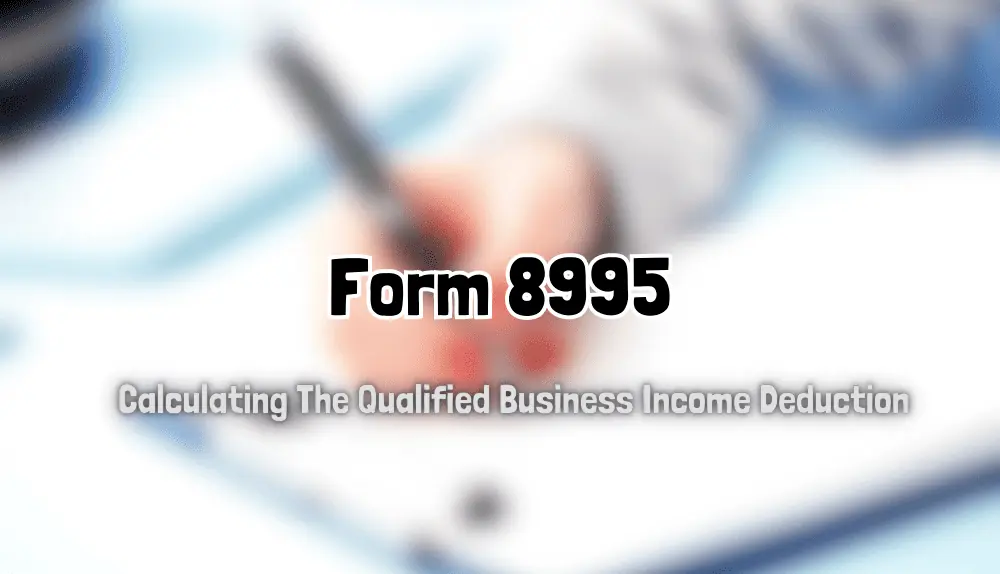Here is a detailed guide to using Form 8995 and figuring out the Qualified Business Income (QBI) deduction. It’s critical for American business owners and independent contractors to learn how to maximize tax deductions. For qualified taxpayers, the QBI deduction, which was included in the Tax Cuts and Jobs Act of 2017, offers considerable tax advantages. The IRS form used to compute and claim this deduction is Form 8995. The QBI deduction, the essentials of Form 8995, and how to optimize tax savings are all covered in this article.
Understanding the Form 8995 Qualified Business Income Deduction

For eligible pass-through businesses, such as partnerships, S corporations, sole proprietorships, and specific real estate investment trusts, the qualified business income deduction is intended to reduce their tax obligations. Subject to certain restrictions, it enables taxpayers to deduct up to 20% of their eligible company income.
The Tax Cuts and Jobs Act included a tax provision known as the qualifying business income deduction that enables qualifying firms and self-employed people to deduct a percentage of their qualified business income from their taxable income.
Taxpayers who want to take advantage of this deduction must submit Form 8995, “Qualified Business Income Deduction Simplified Computation.” The purpose of Form 8995 is to assist taxpayers in computing the deduction and determining their eligibility in light of numerous criteria, such as the type of income, the nature of the business entity, and the thresholds for taxable income. For qualified taxpayers, the form offers a condensed computation method that makes navigating the deduction’s intricacies simpler.
To correctly claim the QBI Deduction and maximize their tax benefits, taxpayers must comprehend the guidelines and conditions listed in Form 8995. The potential savings under this provision can be maximized by seeking advice from a skilled tax professional or using trustworthy tax software to assure compliance.
Eligibility for the Qualified Business Income Deduction
A number of requirements must be satisfied in order to qualify for the Qualified Business Income (QBI) Deduction under Form 8995. First off, everyone who has qualified business income from a domestic firm—including people, estates, and trusts—is eligible for the deduction. A sole proprietorship, partnership, S corporation, or even a real estate investment trust (REIT) may create this income.
It’s crucial to keep in mind that some business forms, such C companies, do not qualify for the deduction. There are other income restrictions that are determined by the taxpayer’s filing status and taxable income. Restrictions may apply to higher-income taxpayers, particularly if their line of work falls under the category of a specified service trade or business (SSTB), such as the legal, medical, accounting, consulting, or performing arts.
The deduction may be capped or gradually eliminated in such circumstances. When creating Form 8995, it is essential to comprehend these qualifying conditions as it assures accurate reporting and adherence to tax laws. Based on the particulars of the taxpayer, consulting with a tax expert can offer additional advice.
Calculating the Qualified Business Income Deduction
A step-by-step procedure is required to calculate the Qualified Business Income (QBI) Deduction under Form 8995 in order to ascertain the qualifying deduction amount. Taxpayers must first figure out their qualified business income (QBI), which is the net profit they made from their permitted business activities. Profits from partnerships, S companies, single proprietorships, and particular real estate investments are included in this. After the QBI has been established, some modifications and restrictions might be implemented. The deduction may be easily calculated for taxpayers whose taxable income is below specific levels.
However, there are additional considerations and restrictions that apply to taxpayers with higher incomes or those who have eligible business income from certain service trades or businesses (SSTBs). Subject to restrictions like the unadjusted basis of eligible property and W-2 earnings paid by the business, the deduction amount is typically calculated as a percentage of the QBI. Taxpayers can calculate their Qualified Business Income Deduction accurately, maximizing their tax benefits while ensuring compliance with the relevant tax rules and regulations, by carefully following the directions and guidelines provided in Form 8995.
Limitations and Phase-Outs

Taxpayers should be aware that the Qualified Business Income (QBI) deduction under Form 8995 is subject to a number of restrictions and phase-outs. One restriction is that the deduction cannot be greater than the taxpayer’s annual taxable income, net of any capital gains or losses.
This means that the deduction will be capped at the taxable income amount if the estimated QBI deduction is larger than the taxable income. Additionally, depending on the taxpayer’s income level, additional restrictions and phase-outs may apply to specific specified service trades or companies (SSTBs), such as law, accounting, health, and consulting services, among others.
The QBI deduction for SSTBs gradually phases out until it is fully abolished as the taxpayer’s income rises above specific limits. Taxpayers must carefully manage these restrictions and phase-outs in order to maximize their QBI deduction when completing Form 8995 and accurately compute it.
Form 8995 – Overview and Usage
A methodology for computing the Qualified Business Income (QBI) deduction, a significant tax break for qualified individuals, trusts, and estates, is provided via Form 8995 to taxpayers. With this deduction, qualified business income from partnerships, S companies, sole proprietorships, and specific real estate investments can be written off up to 20% for eligible taxpayers.
The QBI of the taxpayer is reported on the form, along with other pertinent data, including W-2 wages earned by the QBI, the unadjusted basis of QBI property, and the total deduction amount. Taxpayers can lessen their taxable income and possibly their overall tax obligation by accurately completing Form 8995.
It is significant to note that extra calculations and supporting evidence can be necessary to correctly complete the form, depending on the intricacy of the taxpayer’s business structure and income sources. To ensure appropriate calculation and use of the QBI deduction, it may be helpful to seek expert tax guidance or to refer to the IRS’s published instructions for Form 8995.
Parts of Form 8995
There are various sections on Form 8995 that are crucial for figuring out the Qualified Business Income (QBI) deduction. Information about the taxpayer’s qualified business income, including income, deductions, and losses from qualified enterprises, is reported in Part I of the form.
Each qualifying trade or business, the taxpayer’s portion of the QBI, and any specified service trade or business (SSTB) revenue must be disclosed in full to the IRS. Calculating the QBI deduction for taxpayers with taxable income below the threshold is the focus of Part II. The aggregate QBI deduction amount and 20% of the taxpayer’s taxable income, excluding capital gains and losses, will be compared to determine which is smaller in this section. Part III is applicable to taxpayers whose taxable income is above the threshold and includes additional calculations and SSTB-related constraints. Based on the taxpa
yer’s income and the phase-out criteria, this section assists in calculating the QBI deduction amount. It is essential to correctly complete these sections of Form 8995 in order to compute and claim the QBI deduction in accordance with the precise requirements established by the IRS.
Completing Form 8995
There are numerous crucial steps to take while completing Form 8995 to determine the Qualified Business Income (QBI) deduction. Taxpayers must first acquire all relevant data on their qualified business revenue, such as income, deductions, and losses from qualifying firms. Part I of the form, where taxpayers detail each qualifying trade or business, their portion of the QBI, and any specified service trade or business (SSTB) income, requests this information.
Depending on their level of taxable income, taxpayers move on to Part II or Part III after appropriately reporting the QBI information. Taxpayers who have taxable income below the threshold can determine their QBI deduction in Part II by dividing it by 20% of their taxable income, excluding capital gains and losses, or by the combined QBI deduction amount, whichever is smaller. Part III kicks in for taxpayers with taxable income above the cutoff and includes additional calculations and restrictions on SSTBs.
The income of the taxpayer and the phase-out levels are used in this section to calculate the QBI deduction amount. While filling out Form 8995, it’s crucial to pay close attention to the IRS’s instructions and double-check the figures to ensure correctness. Individuals who may have complex business structures or many revenue sources may find it advantageous to seek professional tax guidance or to refer to the IRS’s official instructions.
Filing Requirements
The unique circumstances of the taxpayer will determine the filing requirements for determining the Qualified Business Income (QBI) deduction on Form 8995. Generally, if a person, trust, or estate has eligible business income from a partnership, an S corporation, a sole proprietorship, or certain real estate interests, they must submit Form 8995. The taxpayer might be able to claim the QBI deduction without submitting Form 8995 if their QBI is below the required level and they are not operating a designated service trade or company (SSTB).
It is crucial to remember that even if the taxpayer is exempt from filing Form 8995, they must still use the proper procedure to declare the QBI deduction on their tax return. To determine their filing obligations and assure compliance with the regulations for calculating the QBI deduction under Form 8995, taxpayers should carefully consider the IRS instructions and contact a tax professional.
Evaluating Entity Structures
Evaluating entity structures is essential when computing the Qualified Business Income (QBI) deduction under Form 8995 to maximize the deduction. The QBI deduction can be significantly impacted by the choice of company structure, such as partnerships, S corporations, or sole proprietorships.
The qualifications and considerations for computing the deduction vary depending on the entity structure. For instance, S corporations and partnerships transfer the QBI to their owners, who subsequently report it on their tax returns. QBI is directly reported by sole proprietorships on Schedule C of an individual tax return. It is crucial to consider aspects including the company’s type, income levels, involvement in specified service trades or businesses (SSTB), and the accessibility of W-2 pay and eligible property.
Taxpayers can choose the most advantageous method for calculating and maximizing their QBI deduction under Form 8995 by carefully examining organization structures, potentially lowering their overall tax liability. To maximize the QBI deduction and make educated decisions on company structures, it is recommended to seek competent tax guidance.
Conclusion
In conclusion, Form 8995 must be understood and used correctly to calculate and maximize the Qualified Business Income (QBI) deduction. The form offers a simplified method to calculate the deduction and establish eligibility based on several factors.
Taxpayers are subject to many conditions, including the possession of qualifying company revenue and adherence to certain income limits and caps. Taxpayers can precisely compute their QBI deduction by carefully filling out the form, potentially lowering their tax responsibilities. It is important to consider entity structures when analyzing constraints and phase-outs that may be applicable to maximize the deduction.
The IRS guidelines or professional tax advice can both be very helpful resources for managing Form 8995’s intricacies and maintaining compliance with tax regulations. Taxpayers can maximize their tax benefits and improve their overall tax position by comprehending the nuances of the QBI deduction and correctly completing Form 8995.

